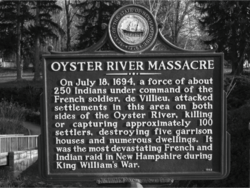Raid on Oyster River facts for kids
Quick facts for kids Raid on Oyster River |
|||||||
|---|---|---|---|---|---|---|---|
| Part of King William's War | |||||||
 New Hampshire historical marker (number 50) in Durham |
|||||||
|
|||||||
| Belligerents | |||||||
| New France Wabanaki Confederacy (Abenaki, Maliseet) |
|||||||
| Commanders and leaders | |||||||
| Francis Drew Thomas Pickford John Woodman |
Claude-Sébastien de Villieu Louis-Pierre Thury Bomazeen Captain Nathaniel |
||||||
| Strength | |||||||
| unknown | 250 Abenaki Indians | ||||||
| Casualties and losses | |||||||
| 104 inhabitants were killed and 27 taken captive | unknown | ||||||
The Raid on Oyster River was a surprise attack that happened on July 18, 1694. It took place during a big conflict called King William's War. This event occurred in what is now Durham, New Hampshire. It is also sometimes called the Oyster River Massacre because of how many people were affected.
Contents
Why the Raid Happened
To understand the raid, we need to look at what was happening before it. In 1689, there was another attack called the Siege of Pemaquid (1689). After this, the English in Massachusetts sent 600 soldiers to protect their border areas. Even with these soldiers, Native American groups attacked Oyster River, killing 21 people and taking others captive.
Later, in 1693, the English leaders in Boston tried to make peace with the Abenaki tribes. They wanted to trade goods and stop the fighting. However, the French governor in Quebec, named Frontenac, did not want this peace to happen. He wanted to stop the English and Native Americans from becoming friends.
French Plans to Stop Peace
Governor Frontenac sent a French officer named Claude-Sébastien de Villieu to the area. Villieu's job was to gather the Native American groups who were allied with the French. He was told to lead them in attacks against the English settlements. Villieu spent the winter at Fort Nashwaak, preparing his forces.
At first, some Native American groups were not sure if they wanted to attack the English. But after Villieu talked with them, and with support from French priests like Father Louis-Pierre Thury, they decided to go on the offensive. This meant they would launch attacks.
The Attack on Oyster River
The English settlement at Oyster River was spread out on both sides of the Oyster River. On the day of the raid, Villieu led about 250 Abenaki warriors. These warriors came from different groups, including the Penobscot and Norridgewock tribes. Their leader was a sagamore (a chief) named Bomazeen. Some Maliseet warriors from Medoctec also joined the attack.
How the Raid Unfolded
The attackers split into two groups to hit the settlement from different sides. Villieu led one group, and the Native American leaders led the other. The raid began very early in the morning, at daybreak. The small forts and protected houses (called garrisons) in the settlement quickly fell to the attackers.
The raid was very destructive. A total of 104 people living in Oyster River were killed. Another 27 people were captured and taken away. About half of the homes and garrisons were looted and then burned to the ground. The attackers also destroyed crops and killed farm animals. This caused great hardship for the people who survived, leaving them without food or shelter.
What Happened After
After the successful raid on Oyster River, Claude-Sébastien de Villieu moved on to a new role. He joined the Acadian Governor, Joseph Robineau de Villebon, as the commander of Fort Nashwaak. This fort was the capital of Acadia, a French colony in North America.

